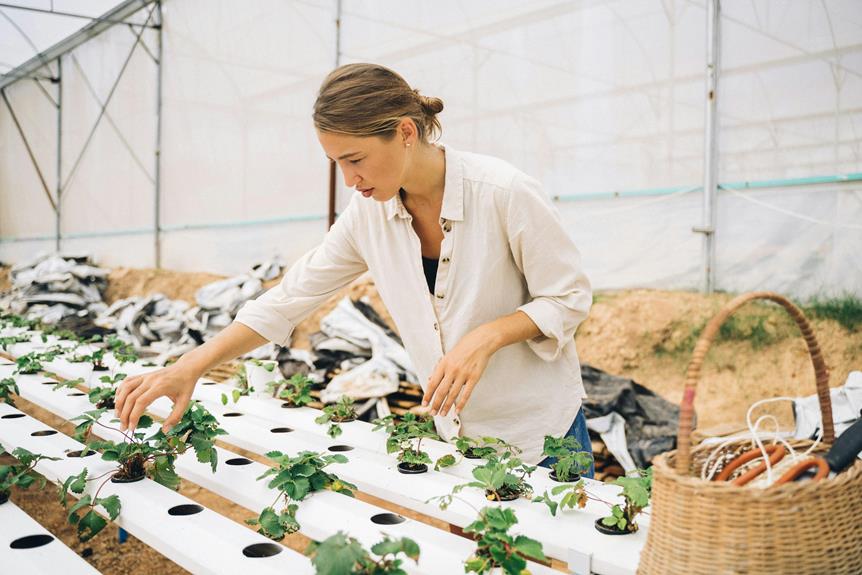Building your own Aerogarden can transform how you approach indoor gardening, offering a compact, soil-free solution to growing herbs, vegetables, and flowers year-round. You'll start by choosing a suitable container and a nutrient-rich medium that supports plant growth without traditional soil. As you craft your setup, consider the specific needs of your chosen plants—this will guide your decisions on lighting, water cycles, and spatial arrangement. However, one of the most critical yet challenging aspects involves the technical setup, such as ensuring proper light exposure and maintaining a balanced nutrient flow. Curious about how to tackle these technicalities efficiently?
Key Takeaways
- Acquire a watertight container, LED grow lights, a water pump, a timer, and a suitable growing medium like LECA or coconut coir.
- Design your aerogarden layout to accommodate plant heights and ensure adequate space for growth and air circulation.
- Install LED grow lights above the plants, adjusting the height between 6-12 inches to optimize photosynthesis.
- Set up a drip irrigation system connected to a water pump and timer to automate and control watering cycles.
- Regularly monitor water levels, nutrient concentrations, and pH, and make adjustments to maintain optimal growing conditions.
Understanding Aerogardens
An aerogarden lets you cultivate plants indoors without soil, using a technology called hydroponics. This method gives you precise control over your gardening environment. You control the nutrients, water cycles, and light, eliminating the unpredictability of traditional gardening. It's a cleaner, more controlled setup, allowing you to grow herbs, vegetables, or flowers year-round, regardless of external weather conditions.
You'll find that an aerogarden isn't just about ease; it's about empowerment. By adjusting variables like light intensity and nutrient concentrations, you're able to optimize plant growth and maximize yield. Imagine tweaking conditions to suit each plant type perfectly – that's the level of control you have. You aren't at the mercy of the soil quality or seasonal changes. Instead, you create the perfect conditions for growth directly in your living space.
Moreover, hydroponics reduces the risk of pests and diseases. Since it's a closed system, common soil-borne diseases are largely avoided. This feature simplifies maintenance and reduces the need for chemical pesticides, providing a healthier environment for both you and your plants.
Embrace the power of an aerogarden and enjoy the benefits of tailor-made gardening at your fingertips.
Gathering Necessary Materials
Now that you understand what an aerogarden is, let's gather the materials you'll need to build your own.
Start by obtaining a container. This could be anything from a simple plastic tub to a more sophisticated glass tank, depending on your aesthetic preference and budget. Make sure it's watertight and at least 6-8 inches deep to accommodate your plants' roots.
Next, you'll need a growing medium. Lightweight expanded clay aggregate (LECA) or coconut coir are great options as they provide excellent support and moisture retention without the mess of soil.
Pick up a reliable water pump; this will keep water circulating, ensuring your plants receive the nutrients they need from the water solution. You'll also require tubing to connect the pump to the water reservoir.
Invest in a proper LED grow light. It's essential for photosynthesis and the overall growth of your plants. Look for one with adjustable settings to control light intensity based on plant growth stages.
Lastly, don't forget a timer to automate the light and water cycles, ensuring your aerogarden runs efficiently without constant manual intervention.
This setup gives you the control to optimize growth conditions and achieve the best results from your aerogarden.
Choosing the Right Plants
Choosing the right plants often determines how successful your aerogarden will be. You'll want to select species that not only thrive in a controlled, soil-free environment but also suit your personal preferences and the space you have available.
Start by considering leafy greens like lettuce, spinach, and kale, which are notoriously easy to grow and maintain. They don't demand much space and will give you quick results, providing you with fresh produce in just a few weeks.
Herbs are another great choice for your aerogarden. Options like basil, cilantro, parsley, and mint require minimal effort, and you'll love the convenience of having fresh herbs at your fingertips. They're perfect for beginners and can add a burst of flavor to your meals without the hassle of store-bought, often wilted alternatives.
If you're leaning towards something more challenging, why not try cherry tomatoes or chili peppers? These plants need a bit more attention and a longer growth period, but the payoff is substantial. You'll be able to control their environment precisely, ensuring the best possible growth and yield.
Designing Your Aerogarden Setup
After selecting your plants, it's time to focus on crafting the layout of your aerogarden to optimize growth and maintenance. You'll want to start by deciding the overall size and shape of your garden. Consider the space you've got available. A modular design might suit you best, allowing for adjustments as your plants grow or as your needs change.
Next, think about the placement of each type of plant. Taller plants should go at the back or sides so they don't shade the shorter ones. It's important to make sure each plant has enough space not only for air circulation but also for ease of access when you need to prune or harvest.
You'll also need to plan for the growth medium. Decide whether you'll use a single type for all plants or customize according to each plant's specific needs. This customization lets you control nutrients and moisture levels more precisely, enhancing plant health and yield.
Installing Lighting and Irrigation
How should you install effective lighting and irrigation systems for your aerogarden to guarantee maximum growth?
For starters, choose LED grow lights. These are energy-efficient and provide a full spectrum of light, critical for your plants' photosynthesis and overall health. Position the lights about 6 to 12 inches above your plants, adjusting as they grow. This close proximity ensures your plants receive intense, direct light without scorching them.
Next, set up your irrigation system. A simple drip irrigation kit can be very effective. It allows you to control the amount of water each plant receives, ensuring the best hydration based on specific plant needs. Connect your water pump to the timer. Set it to water your plants at least twice a day—early morning and late evening. This timing mimics natural dew and reduces water evaporation.
Control is key, so invest in a digital timer for both your lights and water pump. This lets you automate the daily operations, ensuring consistency in your plants' light and water supply.
With these systems in place, you're making sure that your aerogarden operates efficiently, giving your plants the precise resources they need to thrive robustly.
Daily Maintenance Tips
Now that your aerogarden's lighting and irrigation are set up, let's focus on daily maintenance to keep your plants thriving.
You'll need to check the water levels every day. It's vital; even a day without adequate water can stress your plants. Make it a routine—maybe every morning as you check your email or have your coffee.
Next, verify nutrient levels. Your plants' growth depends on consistent nutrition. Most systems need a nutrient refill every two weeks, but daily checks help you catch any sudden deficiencies. Adjust as necessary, bearing in mind that more isn't always better; you're aiming for balance.
Monitoring pH is also crucial. A slight shift can affect nutrient uptake. Invest in a good pH meter and check it regularly. If it's off, adjust it right away to prevent any negative impacts on plant health.
Lastly, keep an eye on plant growth. Trim any overgrowth or dead leaves to prevent mold and ensure adequate air circulation. This isn't just about aesthetics; it's about maintaining a healthy environment where every plant can access light and air equally.
These tasks will take just a few minutes but are essential in maximizing your aerogarden's potential and keeping you in control.
Troubleshooting Common Issues
Despite your best efforts, you might encounter some common issues that can affect your aerogarden's performance. Don't worry, you've got the power to fix these quickly and efficiently.
If your plants aren't growing as expected, it's often a sign of inadequate light or nutrient imbalance. Make sure your lights are positioned correctly, typically no more than a few inches above the plants. Also, check if you're following the feeding schedule recommended for your specific plant types.
If you notice algae growth, it's important to reduce light exposure to the nutrient solution. Cover any exposed surfaces that aren't in use and make sure your water level isn't too high, as this can promote unwanted algae. Regular cleaning of your system also helps prevent this issue.
Should your aerogarden pump start making unusual noises or stop working, first make sure it's not clogged with roots or debris. Cleaning the filter and checking for obstructions can often restore its functionality. If the problem persists, recalibrating the pump or replacing it might be necessary.





Konnichiwa! (Hello!) I'm Pat Tokuyama, a Japanese tofu cookbook author, who travels for music, food, and adventure. If you like Japanese tea, checkout some of the newestorganic japanese tea, matcha bowls and noren and more!
** Curious about the Plant Based Japanese Cooking Club? ** Learn more here!